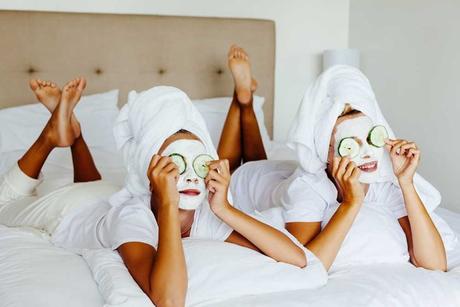
What is Clean Beauty, and why is the world going crazy over it? Well, you must have heard celebrities talk about biodegradable, recyclable, green, eco-friendly cosmetic products. Oh, how, they love it, right?
You feel beautiful while saving the environment. It’s a win-win for celebrities who have an image to maintain. On the other hand, indie brands to the biggest names in the industry are opting for cleaner beauty products and cosmetics.
But are these terminologies of cruelty-free, carbon positive, eco cert real? Or is it all a white lie branded to be perceived as the most needed product ever! Guess this is the right time to know people.
Us figuring out the real status of the clean beauty market is more so essential now. Why? Because it’s practically eating up a great part of global sales.
Want to know the stats? You will be shocked, no kidding! Who would have thought this green chemistry would be such a hit.
In the year 2020, beauty products was USD 483 billion total global sales. In 2021, USD 511 billion sales by now. Isn’t this just insane? The clean beauty industry has an annual growth rate of 4.75%. (also very high!)
Alongside, the total revenue is expected to go up to USD 716 billion by the year 2025. That is a huge value in itself. At present, the skincare category already has the largest share of the market. The value stands at a whopping 28.5%!
The Natural Cosmetics market has heavily dominated both the Asia Pacific and America. It accounts for 46% of the market in the Asia Pacific. In America, it contributes to about 24% of the market. An overall, it accounted for about 60% of the total global market.
You will observe the crazy growth of the natural cosmetics industry in the world. It had grown from USD 34 billion in 2018 to a value of USD 38 billion in 2020; imagine a hike of USD 4 billion in just a matter of two years!
The best part is still on the way! This industry is going to become about double by the year 2027. At least, that is what the expectation is. The global market value is bound to rise to at least USD 54.5 billion! Almost a two-times increase from the year 2018.
These stats aren’t just numbers but a representation of how big this industry is and how quickly it is rising to the forefront!
In the year 2020, Clean Beauty Market was valued at USD 5439.6 million. In the states, it is expected to rise to USD 11.5 Billion in 2027! The CAGR is literally 12.07% from 2020 to 2027.
In the coming article, we’ll be looking at Clean Beauty as a whole industry in itself! Also to be noted is that this industry is different from natural and organic beauty. Yeah, I know they are used in place of each other, and that is what I will clear today!
Fun fact, the trend #cleanbeauty is a huge hit on TikTok. It has almost 207 Million Views which is pretty crazy. Not just TikTok views; the Insta posts are around 4.1 million; that is a huge figure also! This hashtag popularity is a good sign for all of us to shift to safe, transparent labeled ingredient products!
Clean Beauty? What Is It?

So I have been rambling on and on about clean beauty and the crazy following it has. Global sales are just out of control, and the world is talking about it, but most importantly, what is clean beauty?
In simple words, Clean Beauty products are created with no suspected ingredients that are toxic in nature. A lot of mindfulness and care goes into the process of clean beauty products production.
The sourced ingredients are ethic compliant. Most importantly, they are healthy for both environment and you! Time to rejoice because you’re saving the planet as you purchase Clean Beauty products.
But the question arises, why now? What is the reason behind the sudden demand for clean beauty products?
As the world is advancing, by all means, greater human health and environmental issues are rising. Everyone has gotten conscious about what the product stands for and whether or not they would be exposed to harmful chemicals. It is one of the biggest causes of the hike in Clean Beauty products and their popularity worldwide!
Now, I shall explain the difference between organic, green, natural, and clean products is. (Yes, they are different, and you better be mindful of that!)
Comparing Clean, Natural, Green, and Organic Products
Yes, you need to read this aloud; clean, natural, green, and organic products are not the same. Although these words are more than often used for one another, these terms are way different.
We have been led to believe that natural and organic products are really good to the skin or clean in nature.
Right? Well, sorry to break your heart, but that’s not true. There are multiple situations wherein the products were organic and not skin-safe. On the other hand, clean products are always skin safe and good for your cuticle!
In brief, yes, these terms are vast and inclusive sometimes. But fundamentally, they are pretty different. In fact, considering them similar is the worst mistake to make for your skin. Read on as I give you explanations of each of them!
Clean: You can scroll up to see what Clean Beauty products are!
Natural: Natural beauty products are just like their name, natural. Hah, basically, these products would be devoid of any synthetic chemicals; natural beauty products are more than often a mineral, animal, or plant byproduct.
Now, this makes it pretty clear that natural beauty products are not vegan! There is a big scam here as well. A large number of cosmetic producers alter their ingredients and call them natural. What do I mean by that?
So there isn’t any specific formal system that lists all the natural ingredients used in cosmetic products. Since there isn’t any proper regulation, many manufacturers mix some natural ingredients with chemical parts and call them natural beauty products.
Since you’re now aware of this very activity, be mindful of the products you buy. Always check their ingredients in the related ingredient dictionary. This checking will give you an idea of how natural the product actually is!
Organic: The world is going organic, it seems! Everything is being turned into organic counterparts. Right?
Organic products are produced according to organic farming regulations. What are these standards, though? No chemical fertilizers, growth hormones, or any genetic modification is used. Yep, it’s pretty ‘organic’ per se.
The great news is that, unlike clean or natural products. Organic products are generally regulated. So you will be getting what you are told. Many countries have rules that classify products as certified organic.
Do keep in mind that many times, organic products are not labeled as certified organic. That doesn’t mean that they aren’t actually organic. It is because certifications cost a lot of money. Some brands would prefer to label their products independently as organic, which is legal as well!
The only time this lease counteracts is when some brands label themselves as organic when the amount of certified organic ingredients is a dismal 1%. What a waste of money and breach of trust it would be! Real organic products should have at least 70 to 95% certified organic ingredients.
What is important here is that not even a product that qualifies as an organic product should be considered as truly organic. Products with preservatives are basically necessary for their production; These preservatives will be synthesized in labs and not obtained organically.
Green: Last but not least, we come to green products. Green products are actually products with real “green” ingredients. What do I mean by that? Green beauty products will be sourced, produced, and packed in a sustainable, ethically compliant way!
Green beauty is also referred to as eco beauty! You can be stress-free about their origins.
The Strictly No No list of Clean Beauty Products
Listed below are some of the ingredients you need to be wary of. To say the least, they are toxic and will affect your skin and body in multiple ways.
- Parabens: (methyl-, isobutyl-, propyl- and others) These preservatives prevent mold and bacteria growth in products. Parabens are also essentially endocrine disruptors.
They can alter the hormone mechanisms in the body. Parabens are usually found in face cleansers, shampoos, body wash, and foundations. - Sulfates: Sulfates such as Sodium Lauryl Sulfate, Sodium Laureth Sulfate, SLS, and SLES cause allergies and also trigger skin irritations! SLES has contaminations of 1,4-dioxane. It is a byproduct of a petrochemical process called ethoxylation. This process is used to make chemicals less harsh! You can find sulfates in shampoo, body wash, and bubble baths.
- Lead
- Hydroquinone: Found in skin lightening creams, Hydroquinone doesn’t allow melanin production on your skin. Excessive use is related to skin cancer, skin irritation, and organ toxicity.
- Synthetic fragrance or flavor: A chemically produced scent can contain more than 3,000 synthetic ingredients such as hormone disruptors and allergens. Federal Law’s Classification of Trade Secrets protects fragrance formulas. Because of this very reason, they are undisclosed, and almost all cosmetics have synthetic fragrances.
- Diethanolamine
- Triclosan: Triclosan is an antimicrobial oestocode. It is extremely toxic to the water world. Triclosan also affects the human reproductive system in more ways than one. It is present in Soap bars, Liquid soaps, and toothpaste.
- Chemical UV Filters: Largely found in sunscreens. Oxybenzone and Octinoxate (Octyl methoxycinnamate).
- BHA and BHT: (Butylatedhydroxy Anisole and Butylated Hydroxytoluene). These two synthetic antioxidants found great usage in lipsticks and the moisturizing cream manufacturing process. Ther are big-time preservatives. According to the European Commission, BHA and BHT both disrupt the endocrine system.
- Coal Tar Dyes: Ever seen the labels of p-phenylenediamine or colors titled “CI” and followed by a five-digit number? These are coal tar dyes. Coal tar dyes are harmful to human beings and have been connected to cancer time and again.
- Formaldehyde-releasing Preservatives: A range of cosmetics has Formaldehyde Releasing Preservatives; you will also find it in cleaning products like Toilet Bowl Cleaners. Just as their name says, these preservatives release Formaldehyde which is a carcinogen.
- Aluminum: Antiperspirants have a large quantity of aluminum. It enters the body via the underarm tissue and then blocks the sweat ducts. You can also be subject to disorders such as Alzheimer’s Disease, Osteoporosis, and Breast Cancer.
- Dibutyl Phthalate: This chemical is generally present in nail products. It is also a solvent for dyes. The biggest harm is centered towards the human reproduction system by its use. It also promoted other chemicals to initiate genetic mutations in humans.
- Polyethelene Glycol: PEG compunds are present in solvents, thickeners, moisture carriers, and softeners. They can be contaminated on varying levels depending on the manufacturing process. Contaminants include ethylene oxide and 1,4-dioxane. Both of which are carcinogens in nature.
- Retinyl Palmitate: It constitutes palmitic acid and retinol (Vitamin A). According to an FDA study, retinyl palmitate, when exposed to the skin in sunlight, paves the way to multiple issues such as lesions and photosensitization. Daily application of Vitamin A creams will be responsible for health problems. Norwegian and German Health agencies have attested to this.
- Toluene: Toluene is a volatile photochemical solvent. It is toxic to the immune system and causes congenital disabilities. Toluene is mostly found in nail polishes.
- Ethanolamines (MEA/DEA/TEA) are largely found in dry cleaning solvents, fragrances, sunscreens, mascara, foundation, and hair dyes. These surfactants and pH adjusters more than often cause skin toxicity, inhibited fetal brain development, and hormone disruption.
- Ethylenediaminetetraacetic acid (EDTA) This is a chelating agent which helps in the stability of cosmetics. It is very toxic to organs. You will find this in hair color and moisturizers.
- Benzalkonium Chloride: This ingredient is largely found in sunscreens and moisturizers. It is used as a preservative and surfactant. Benzalkonium Chloride causes respiratory irritation, allergies, and severe skin and eye issues!
Can Clean Beauty Stand Alone? Is Green Beauty Necessary?
So, there you go, the elephant in the room. Do we need actually need green beauty, or is Clean Beauty enough?
Clean Beauty corresponds to the usage of sustainable sourcing and production. The ingredients used are environmentally friendly. Sustainable packaging must be environmentally conscious at all costs.
Most consumers are okay with the cost and research when it comes to sustainable cosmetics. The top draws of green cosmetics will have to be increased effectiveness, long-term health, and environmental responsibility.
Sustainability is a two-way road, right? Not just the corporate value but personal values in every employee should be aligned.
They need to understand how harmful or harmless such products can be. These members are essentially responsible for employee health. The company should, by all means, deliver to the standards promised to the employee!
Many companies are investing time and resources to educate their employees regarding the importance of sustainability. It is also essential to understand that this sustainability itself will be responsible for the year on year profits,
Doing so will also increase the legit green products in the market, thereby killing off the prevalence of fake ones.
What Are the Advantages of Green Beauty?

When we talk about environmentally friendly products, we don’t refer to decreasing costs or low quality. Green beauty essentially means the small yet steady steps towards sustainability. These steps will genuinely increase sales and the public’s opinion!
- Better Product Quality
Who doesn’t love better product quality? Both the consumers and the manufacturers appreciate great product quality. The best part of high-quality products is that they don’t put users at any risk.
Some petrochemical products, such as mineral oil, are responsible for causing cancer! Bio-based products enhance non-toxicity. This anti-toxicity itself helps the manufacturer in producing safer and high-quality products. - Improved Brand Reputation
By now, we are all aware that brand reputation matters a lot. Green products simply mean the company cares about the user and environment as much as they care about their profits! As simple as that!
Consumers are completely inclined toward firms that are more transparent and honest. Sustainable, green products can enhance the brand’s social and global reputation.
This will only help them in constructing a loyal customer base. Most of us never even change our cosmetics company if they work well for us! - Increased Corporate Responsibility
Green cosmetics are call for cosmetic companies to increase their corporate responsibility standards. An increase in sustainability initiatives helps companies take ownership of their impact on the international economies and health.
More corporate Social Responsibility showcases the companies authority and consumer respect all over the globe. Companies also gain value amongst suppliers and the distribution claim.
Pushing Clean Beauty As Forward As We Can!
How important is Clean Beauty, though? Well important enough for lawmakers to make a new bill regarding popular beauty products that cause cancer!
PFAS chemicals were found in multiple US makeup products, according to a study! Yeah, you heard me right.
The bill I just mentioned is happening after the study done by The University of Notre Dame. This study tested products like Ulta Beauty, Sephora, Target, and Bed Bath & Beyond.
The results might shock you! About more than 50% of the 231 tested makeup products have indicators of per- and polyfluoroalkyl substances (PFAS).
PFAS is a very toxic category of chemicals. Users should, by all means, stay away! The No PFAS in Cosmetic Act and the Personal Care Products Safety Act are definitely here to stay.
As user consciousness increases, the FDA needs to have regulatory power over cosmetic product ingredients.
In fact, The Personal Care Products Safety Act would need companies to hand over their raw materials directly to the FDA. Once this is done, the FDA themselves will determine the harm that is possible to the consumers.

Final Thoughts
As I draw this article to a close, I reiterate the fact that the real essence of green beauty has non-toxic attributes and results. Clean Beauty products simply do not contain any harmful ingredients or any component that negatively affects human health.
Another point to be kept in mind is that clean most definitely does not mean Organic or natural beauty. These natural and organic products could still be harmful to users. Organic or Natural beauty can’t be considered clean either. There are different entities altogether.
The top priority of a clean beauty product is to be safe. Everything is secondary! If the ingredients are non-toxic (they may be synthetic or non-synthetic), we are good to go in the case of clean beauty. Not so much for Natural or organic beauty products.
Beauty products are only sustainable when they are good to both the people and the environment. Companies should measure their carbon and water prints to make the best sustainable products ever! The overall sustainability is what matters the most. More than the average natural versus synthetic ingredient debate.
The impact in terms of the community and the supply chain impact needs to be measured. It should be changed if, in any case, you feel the impact isn’t as positive.
If you want to win as a cosmetic brand in today’s world, you will have to throw out your old playbooks. Customers are opting for honest and transparent brands. The brand value now depends on your practices as much it depends on your products. You need to ace both of them to win those customers!
Check out my other article Essential Skin Care

